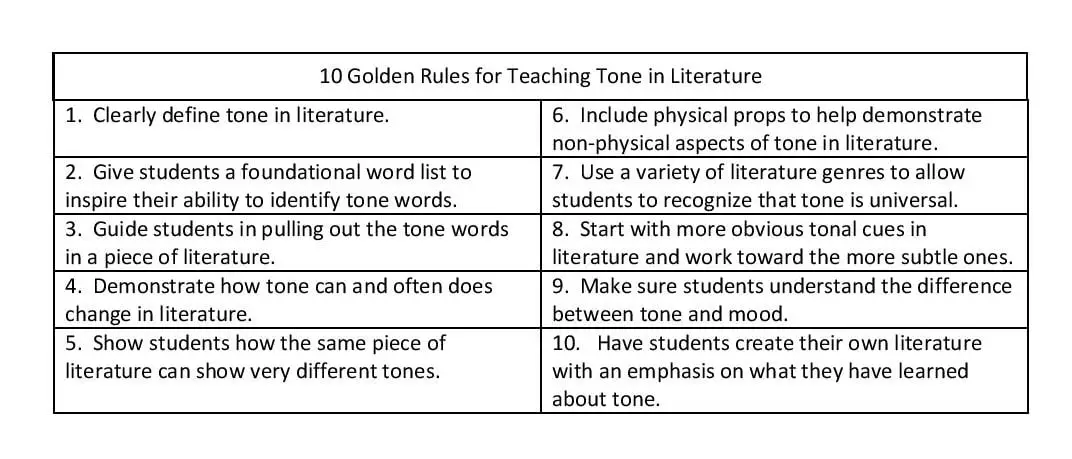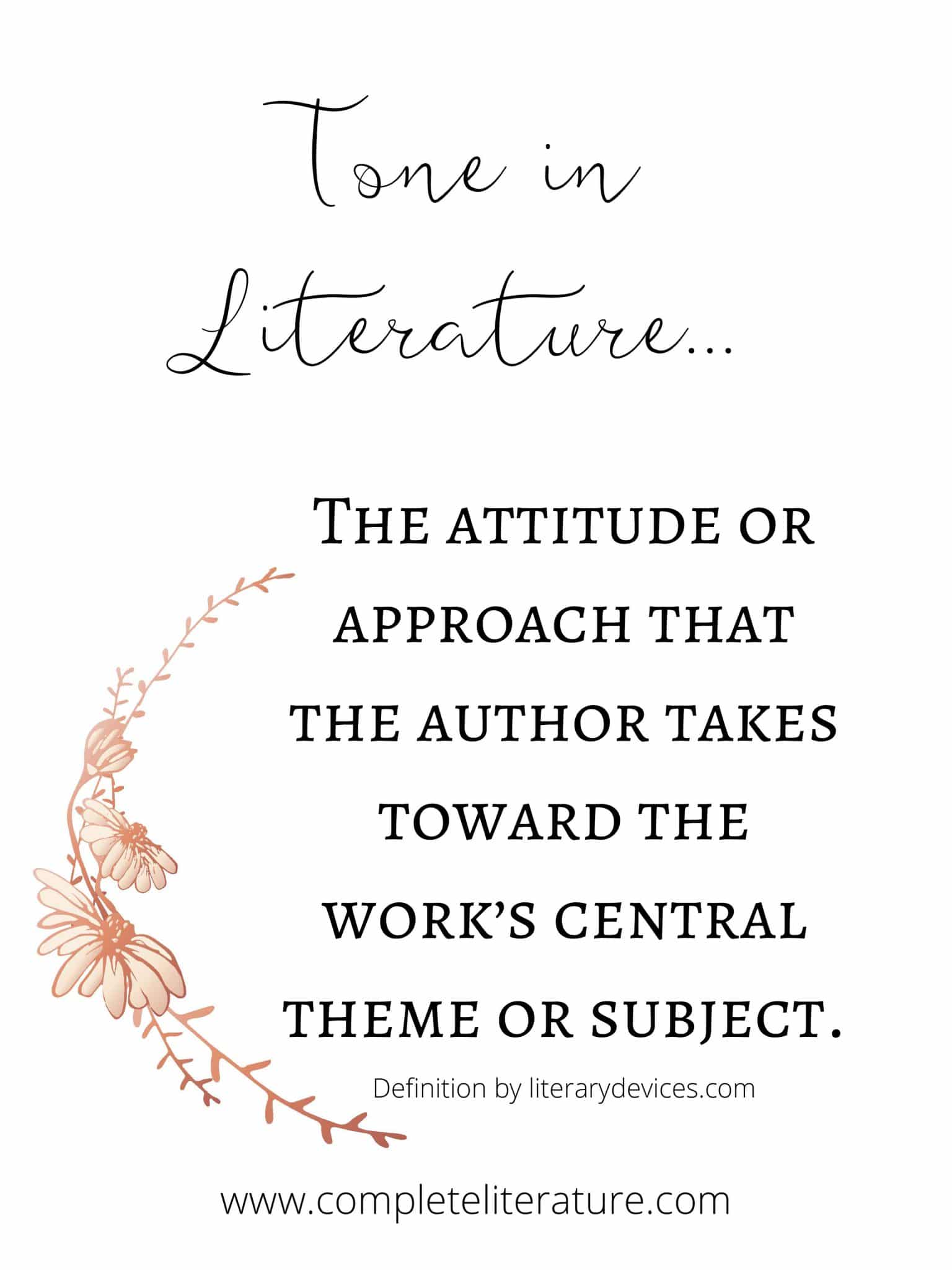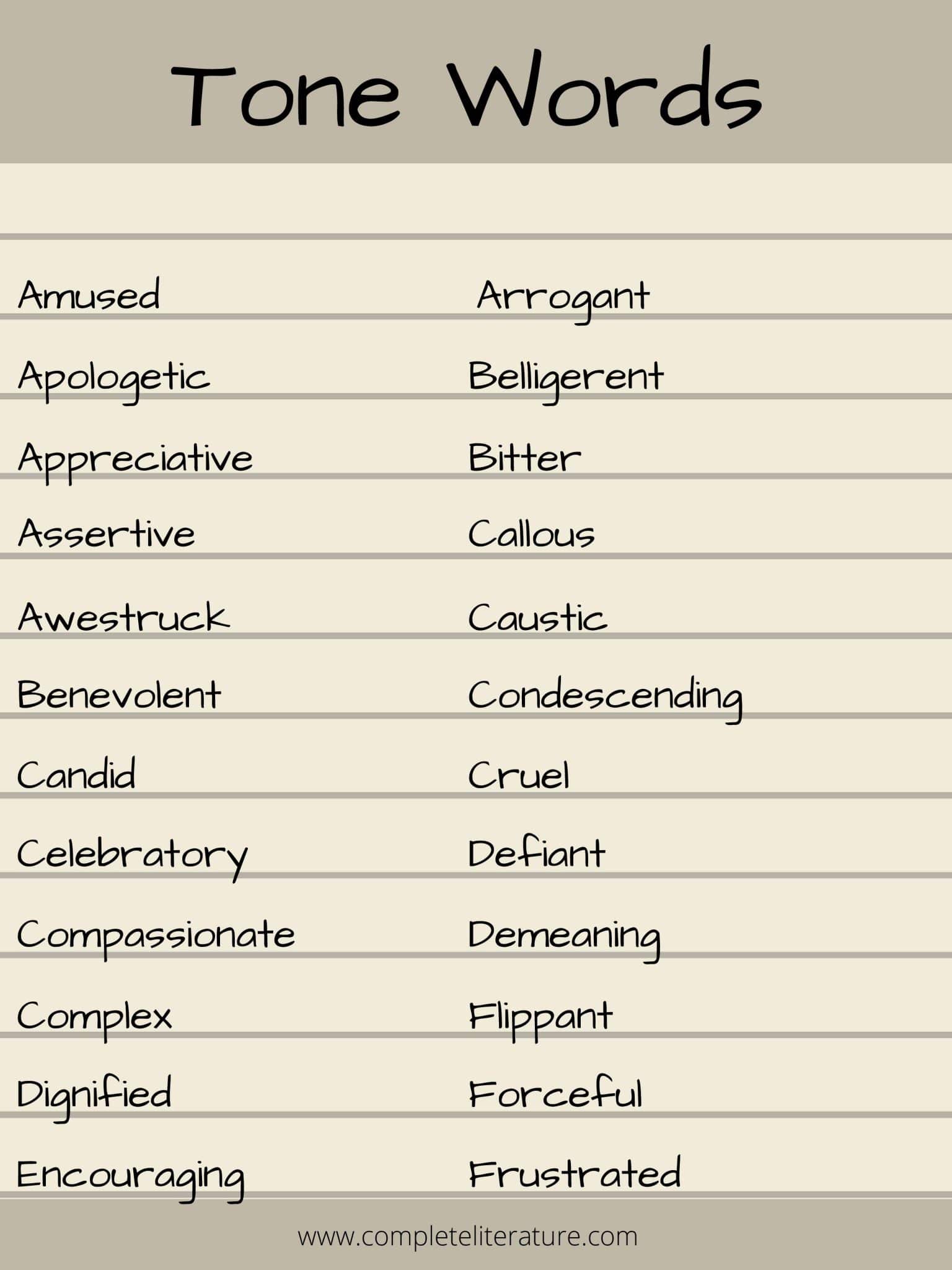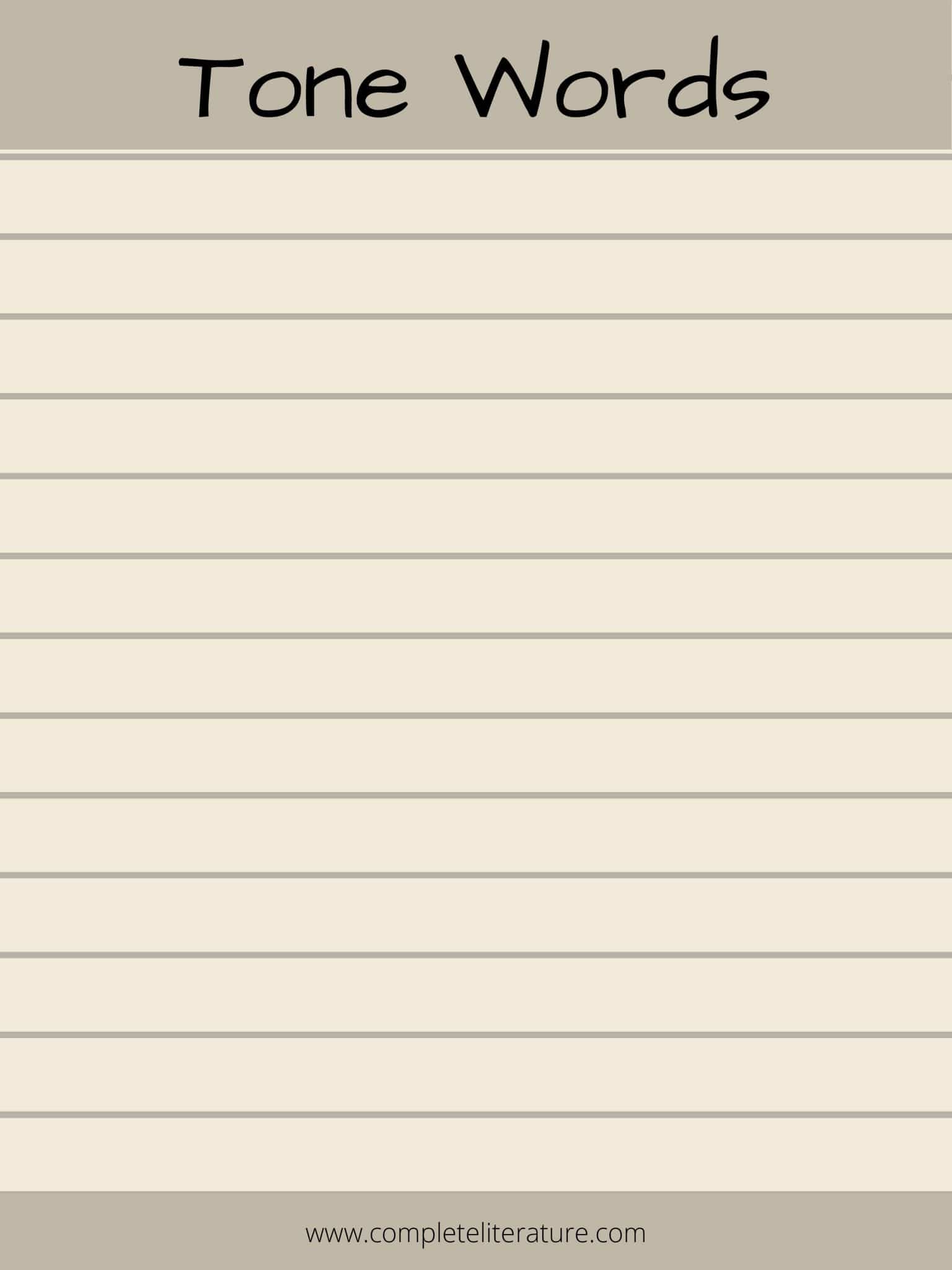Understanding tone in literature is critical to fully understanding and enjoying what you are reading. But because it is not a “tangible” aspect of literature, it is a very hard concept for students to learn.
So how do we effectively teach tone in literature? I spent a good amount of time researching the best ways to teach students concepts of teaching tone in literature that would allow them to comprehend the nuances. And I came up with this list of 10 golden rules for teaching tone in literature:
1. Clearly define tone in literature.
2. Give students a foundational list to inspire their ability to identify “tone words.”
3. Guide students in pulling out the tone words in a piece of literature.
4. Demonstrate how tone can and often does change in literature.
5. Show students how the same piece of literature can show very different tones.
6. Whenever possible, include physical props to help demonstrate non-physical aspects of tone in literature.
7. Have students create their own literature with an emphasis on what they have learned about tone in literature.
8. Use a variety of literature genres to allow the students to recognize that tone in literature is universal.
9. Start with more obvious tonal cues in literature and work toward the more subtle ones until your students are adept at identifying tone in any passage.
10. Make sure students understand the difference between tone and mood in literature.

So now that you have the quick answer, let’s go ahead and unpack exactly what each one of these rules for teaching tone in literature consists of.

Table of Contents
1. Clearly Define Tone in Literature
Every concept we teach must have a clear definition that our students can build a foundation on. In the case of defining tone in literature, students can have a difficult time comprehending exactly what we are teaching. Because of its abstract nature, students who think in terms of “black and white” will have a hard time nailing this one down.
We can help make this a more tangible concept for them with a great definition backed up with some great examples.
According to literarydevices.com, the definition of tone in literature is the attitude or approach that the author takes toward the work’s central theme or subject.
You must be careful that your students do not confuse the author’s attitude or approach for the readers’ thoughts toward the author’s attitude or approach–that is the mood of literature. Giving them some comparisons using a fairly easy piece of literature should help with this. I will also cover it in a bit more detail in Rule #10.
Here is a beautiful printable poster that you can print up for your classroom. You can click on it to print it in full poster size or you can fit to page and hand it out to your students to do with as they wish. I think you will find it a great help in teaching tone in literature in your classroom.

2. Give Students a Foundational List to Inspire Their Ability to Identify Tone Words
If you were to make a list of every word that identifies tone, there would not be enough room or time to cover it all. But that is actually a great thing! If you start with a foundational list, you can then add more words to this list on a regular basis with your students. I have provided a printable starting list that you can use to get you started. I also included a blank one for you to add more words with your class.
You can print it up as a full size poster or fit to page to make it a worksheet and reference page.


The more you build on this list with your students, the more they will be able to identify them on their own over time. It is awesome when one of the students hears a word and recognizes it as a tone word in a completely random conversation. That’s when we teachers know we have successfully taught the concept!
3. Guide Students in Pulling Out the Tone Words in a Piece of Literature
When teaching tone in literature, I always start with a super easy piece of literature so the concept will be obvious to the students. My usual go-to to introduce the concept is Where the Wild Things Are by Maurice Sendak. It has both tone from the author and so much mood from Max as well as his mom. That makes this not only a great opener for the concept but also a great way to teach the difference between tone and mood.
As for the tone aspects, the author shows irritation, excitement, resolve, and restoration. There are many more tones that you can draw out as you get into details.
Discussing the events of the book and why Maurice Sendak chose to write about them will help your students pull out lots of different ideas. And it will be easier for them to recognize these tones because it is a book that the vast majority of your students will have read or had read to them many times over.
Once your students are easily able to draw the tone of the author from picture books and early reader books, you will be ready to move on to more complex books.
Also, helping your students understand that often it is the description of the scene that sets the tone of the reading more than what the characters are saying.
4. Demonstrate How Tone Can and Often Does Change in Literature
There are many reasons that an author’s tone can change in a single piece of literature. It could be to show the reader how an experience totally changed their perspective. Or it could be to surprise the reader. It could be due to wisdom learned over the passage of time. Or it could be just about anything.
In fact, tone changes throughout the course of a literary work far more than it stays the same. This is an incredibly important concept to concentrate on when teaching tone in literature.
Here is a list of some of the most popular reasons for a change in tone in literature:
The plot becomes more complex.
To reflect how current or historical events have changed the world.
To take the plot in a more bizarre direction.
To show the consequences of something that took place in the book.
To show more than one perspective at the same time.
There are almost unlimited reasons for a tonal change in literature. The possibilities are literally as limitless as the author’s imagination.
5. Show Students How the Same Piece of Literature Can Show Very Different Tones
Now that you have shown students why and how literature can have very different tones, it is time to show them some good examples of authors that changed the tone in their work.
The Once and Future King by T.H. White.
This book is one of the best books written on the Arthurian legend. It was published in 1958 and continues to be an incredibly popular book. It was directly based on the book Le Morte d’Arthur by Sir Thomas Malory, which was published in 1485. What makes the tone change so drastically throughout is that it was formed from many smaller works that were collected and revised, with new material added in to make it a cohesive work. It was done in a genius manner.
A Little Princess by Frances Hodgson Burnett
This book is another great example. Although when the story begins, we know that life has been somewhat difficult for Sarah because her mother had passed away. In spite of this, her father raises her well and with great love. Because he is wealthy, he is able to send her to the best schools with the best care while he is serving in the military overseas. The tone turns drastically when news reaches Sarah’s headmistress that Sarah’s father has died. She immediately takes away all of Sarah’s privileged life and makes her effectively a poor servant. The tone takes one more drastic turn as Sarah discovers her father is alive and her life returns back to its former glory.
Because most books actually have a change in tone as the plot progresses, you will be able to come up with many other great examples that will work perfectly with your students.
6. Whenever Possible, Include Physical Props to Help Demonstrate Non-Physical Aspects of Tone in Literature
Because tone is such a non-tangible concept, this is going to be the hardest of all of the rules when you are teaching tone in literature. But once you have started thinking outside the box it will become much easier to implement.
One of the easiest ways to demonstrate this is to recreate a couple of scenes in the book you are studying. To use the example of A Little Princess again, setting up two scenes in your classroom and allowing the students to dress up would beautifully illustrate not only the tones but the stark difference between them.
Having a “lavish” school scene or birthday party scene on one side of the class with a sparsely furnished ragged attic scene on the other would allow the students to get a very dramatic picture of the tones. Adding dress up to this will allow them to actually feel the tone.
The way to figure this out without a whole lot of difficulty is to set up any scene from any book in your classroom. With some thought and creativity, you can do this with very little if any expense most of the time. I usually just walked around my house looking for things that would resemble the scenes of books that we were reading in class.
Once in a while I would look for something at the thrift store if I knew they were likely to have it. And many times I could find the best items at my local dollar store.
Here are a few related articles that I think you will find valuable:
Step-by-step: How to Teach Imagery in Literature
How to Teach Students to Summarize the Right Way
When Should a Child be Able to Read in Their Head?
7. Use a Variety of Literature Genres to Allow the Students to Recognize That Tone in Literature is Universal
This is pretty straightforward so I don’t need to say much else about it. But I would like to point out some other advantages to this rule besides allowing students to recognize the universality of tone.
First, they will experience a wide range of literature. It allow them to read things that they may never have interested them in different circumstances. The good news is that every book ever published has tone, so you will have no shortage of material as you teach tone in literature.
Next, they won’t be bored reading the different genres because they will be looking for something in particular–they will be otherwise engaged and not have the chance to be bored with a general reading of the text.
And finally, they could very well discover a genre that they never would have realized they have an affinity to. This could turn their reading world in a whole new direction!
And there are a couple of advantages to the teacher as well. There is a huge pool of literature you can choose from when you deliberately choose many different genres. And you will be able to please most if not all of your students when you are using that wide variety of genres.
8. Start With More Obvious Tonal Cues and Work Toward More Subtle Tones Until Your Students Become Adept at Identifying Tone in Any Passage
I touched on this concept in rule #3, where I recommended teaching tone in literature by starting with early reader or even picture books.
Because the authors of these books understand that early readers do not yet have a good understanding of tone in literature, they tend to exaggerate the feel of tone in order for students and young readers to see it, whether they can name it as tone or not. And that is what makes it so much easier to teach tone in literature to your students by starting with them and working out to more complex books from there.
9. Make Sure Students Understand the Difference Between Tone and Mood in Literature
This is one more issue I touched on briefly in rule #1. It is so easy to confuse tone in literature with mood of the characters. In some ways they can actually be intertwined, especially because the tone of the book is formed many times by what the characters say and do.
We have pretty well covered what tone in literature is–it is the author’s attitude or approach as written in his/her literary work.
Mood, on the other hand, consists of how you, the reader, feel about what the author has written. Can you both feel the same? Of course. But you can also feel very different from each other based on your perspective.
For example, say you are reading a book about an abandoned house in the woods. The author’s tone can be along the lines of peaceful, or he/she could go in the direction of spooky.
On the other hand, the reader, based on the peaceful tone of the author, could actually feel the same peace. Or the reader could feel stressed because he/she doesn’t have access to the convenience of the city that he/she is used to living with.
Or in the case of the author’s spooky description, the reader can feel fear or terror. Or the reader could feel skepticism.
And that realization brings us to the point that mood can be different for different people. This is likely dependent on the experiences that the reader has before reading of the book. Nobody comes to a book with an empty slate. Whatever experiences they have had in life are going to affect how they feel about what they are reading.
10. Have Students Create Their Own Literature With What They Have Learned about Tone in Literature
Now that your students have gotten a good taste of tone in hopefully a great variety of genres of literature, it’s time to branch out and let them try their hand at it.
I would work backwards with them and have them set the tones first. Then they could build the scenarios around the tones they had chosen. I would also have them pick 2-3 tones so they could experiment with transitioning between them.
This process will almost instantly take their writing skill to the next level. And as you work through it with them, you will love seeing their excitement as they realize how well they can do it on their own!
Conclusion
So these are my 10 Golden Rules for teaching tone in literature. If you follow these rules, your students will not only understand the concept of tone in literature, but will be able to recognize it and create it in their own writing.
I also found this awesome video from Khan Academy that does an excellent job of showing specific verbal examples of tone. Your students will love it! Check it out here:
If you liked this article, I think you will also enjoy the following articles:
What Makes These 10 Books So Well-loved?
The Madeline Hunter Lesson Plan: Should We Still be Using It?







I think these are great rules and something that I would definitely incorporate when teaching my daughter.
Spanish literature deals a lot with tones and I grew up reading lots of novels that describe tones in literature. That’s necessary to get in to the storyline mindset.
I think English may be the worst language at this. Plus I was never taught about it when I was in school. Spanish has always been a more flowery language in so many ways.
This is such an excellent resource, When I was in school, I had a terrible time getting the tone right in my creative writing class.
When I was in school, they didn’t even bother to teach it. Just the basics for us.
I love how comprehensive this gudie is. It’s going to help so many kids with their creative writing. It’s going to help a lot of parents who are homeschooling their kids, as well!
It definitely helped me when I researched it! Thanks for sharing. 🙂
Such in-depth advice to help in teaching this, often misunderstood, concept to students. Love how you have broken this down with easy to follow explanations and examples. Tone is absolutely central to conveying a vision of a story in literature and this is a great resource to properly explain it.
You are right, Nicole. It is so important and yet so seldom focused on.
I never thought about this before. You’re totally right! It is very important to understand tone in literature!
This is a cool post to learn from for anybody who reads it! I did learn something new for sure.
wow. can you believe it but i don’t remember ever learning about tone words before now. :O thanks so much for sharing.
I agree–I was not taught this in school and it would have made such a big difference! Better late than never, though, right? 🙂
Very interesting. I’m not a teacher but I am hoping to be able to incorporate it with my kids. Thank you so much!
It’s definitely a good thing to do with your kids at home! Thanks for sharing, Stephanie!
these are rally fantastic tips as there is a huge difference between tone and mood literature kind regards Pati Robins @ style-squeeze blog
Great blog. I will definitely share this with my friends.
A foundation list to identify tone words is certainly a great idea. My wife is an English teacher and she loved reading the post along with me.Great post for every parent and student. And of course all teachers who can pick up some ideas from here.
Thank you, Subhashish! I am glad your wife enjoyed it as well!
These are some wonderful tips! This would definitely help my kids do better in their creative writing classes 🙂
Oh these are wonderful tips. I was just saying that I want my nephew to be well rounded in reading and writing and this will help so much!
I hope that they help him to enjoy learning to describe things in a more senses-oriented way! Thank you for your thoughtful comment as always! ♥
I really agree with you on the part about attitude, and that goes for both teacher and studen!
I never knew that teaching tone was so intricate. I just kind of gotten it but then again, I’m a lit lover and a lit fan.
I wish it had been as easy for me! I learned it later in life so it didn’t stick as easily as it would have if I were a kid learning it, lol.
You really have passion in what you’re doing, these 10 golden rules will definitely help student learn faster and efficiently.
I hope so, Gervin! Thanks for sharing your thoughts!
The rules are really good and will be efficient for every student who wants to learn more.
All these teaching tone are really golden rules, list of ability to identify tone words to students create their own literature are very much useful for teachers, students and writers too.
Agree completely. Tone on a large scale defines literature. In fact I prefer to follow it when I am homeschooling my son. You have explained with great care. Loved reading and very useful post. In fact in the blogging world too, literature must be strong.
You are absolutely right! I hope my blog is able to help you all even more over time!
These are great ways of teaching tone in literature, especially starting with something easy and obvious. Usually in school you don’t have a choice of what literature pieces you study, at least not in my country unfortunately.
I am sorry for your lack of being able to choose. At least every book has some tone to be able to evaluate, even if it is to show a bad example!
I remember that I struggled with tone quite a lot when I was at school. I think it’s important to use a different literature genres to learn to recognize the tone in literature.
I agree with you about the different genres. It will help students to see more clearly if certain genres are too hard for them. And it definitely widens the reading/writing experience!
I agree with Demonstrate how tone can and often does change in literature. Also, it depends on the teacher.
Anybody who reads this post will learn something new for sure. Thank you for sharing 🙂
This is such a helpful post and not just for kids. Amazing!
You are right–it’s great information for anyone! Thank you for sharing your thoughts.
Sending this straight across to my cousin in the UK who is also a teacher! thanks
Thank you, Emily!
This is absolutely needed in any literature writing, reading and alike. It will definitely help out in learning process.
I am sure that many teachers will find this useful for there students. Also, So will parents x
I love how comprehensive the list is, it’s golden indeed. My niece loved or when I read to her, I’ll put this to practice. Teaching her st a very young age about tones.
You actually can teach tone a little bit, just by talking about it and how our senses encourage it!
What a wonderful post about teaching tone in literature. It is super important as it gives the words feelings, characteristic, and make the story much better.
Great post for anything one trying to learn tone and is interested in literature. It is not an easy thing to teach.
Thank you! You are right, it is not easy to teach.
Great comprehensive guide. There are many things that an adult like me could learn too
Even as a writer these are some good tips to think about while writing!
You are exactly right, Stephen!
This is really an excellent guide in teaching kids. It’s not easy to teach kids on their lessons. Gonna share this with my niece.
My daughter is studying at a pedagogical university. I will share your blog with her. You have a lot of great and useful ideas, especially for those new to the profession. Thanks for sharing.
What an excellent post! These are wonderful guidelines that I think I could even learn from when doing my own writing. Thanks so much for the share!
x J
https://forevertwentysomething.ca
Not a teacher but I find it so helpful. Worth sharing.
I’m not teacher but I find it so helpful. Worth sharing.
These are such great tips. I was a natural reader and writer, so I had no problems with classes like this, but I had some friends who struggled so badly. This would have helped our teachers guide them to a better understanding.
Hhhhmmmm….If I was a teacher of literature, I would surely implement these. Tone is such an important aspect of the language and how it is put to use.
I have read a loot of literature lately and I have never thought about the tone in there. Thanks for this detailed guide.
Super agree with the tone and mood being interchanged oftentimes. Yet another day full of learning for me. Will use this as reference for when the kids are learning about this bit. Thank you, Marie!!
Not only is this a super helpful resource for teachers, but also for parents who will be teaching their children from home this year, due to COVID. Thanks so much for sharing!
That is a great list! Definitely important to define what Tone is, and then contrast it with mood, because those two can get confusing.
This is really helpful!! Thank you so much for sharing this!!
This is awesome! Storytelling is a gift! And even when I read to myself, I always have read in the tone of the character!
Thanks for sharing these tips! Very helpful especially for homeschooling kids.
These are great tips for teachers!
What an excellent resource. Thanks for sharing.
I think these are great rules and thanks for sharing. Tone is such an important aspect of language.
Glad you shared your experience and these tips with us…these are gonna be so helpful and useful one..great work though…
Wow! I had no idea there was so much detail that went into teaching tone in literature. These tips could be beneficial for anybody, not just kids. Thank you for sharing!
Tone and inflection are so important in literature, it can change the entire meaning! I especially love your tip on selecting the tone words. Great foundational step
This is a very important topic for my teacher friends. I’ll send it to them!
hello